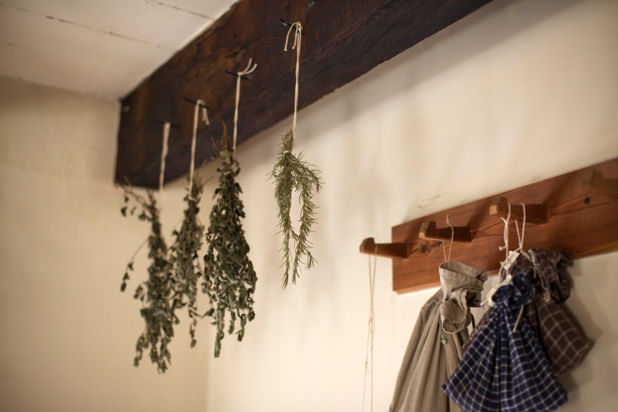I’ve been nurturing a dream of having my own home and land.
A dream of growing my own food and maybe keeping an animal or two. Of having open space for my children to run and play in. Of being close to conveniences, but also a little more self-sufficient.
I want to try homesteading, but the truth is that I can’t yet. Right now, I have a small apartment with no yard to speak of—only a small, concrete deck. While I believe in my dream, I also don’t want to wait until tomorrow to have what I want now.
It’s easy to think that because our situations aren’t perfect, we can’t have what we want. We begin to live for the future, forgetting that the important moments of our lives are happening right now.
But there’s no need to put things off—we can have what we want today.
In fact, I would venture to say that almost anyone can homestead wherever they are right now! It doesn’t have to be on a large scale. But we can incorporate aspects of homesteading into our lives to enjoy part of what we dream for the future.
So what can we do and how can we get started?
One of the easiest ways to start is to grow herbs. Herbs can be grown indoors or outdoors and tend to be easy to care for. Herbs can be used in cooking, for home health remedies, in teas, and even for all-natural pest control. We can put them on counters, windowsills, or walls or in our gardens outside. They don’t take up much space and they have so many uses.
Right now, I have basil, sage, lavender, and rosemary planted. I’m hoping to make my own basil pesto soon, and the herbs also serve a variety of purposes in my home.
Another easy way to homestead is to grow a container garden. We can get creative when choosing containers to grow our vegetables in. We can use paint buckets, gardening pots, or even turn trash into treasure by upcycling old things and turning them into garden containers. Check out Pinterest for upcycling ideas and also for how to build a self-watering container garden.
Check city and county ordinances (and neighborhood associations) for restrictions first, but there are a lot of other ways to homestead in the suburbs, in an urban area, or even in an apartment. Most landlords might object to a cow as a house pet (yes, I jest), but some homeowners are able to keep chickens for their eggs or have space for smaller animals. Beekeeping is an option for some homes, but it would likely be out of the question for an apartment.
Anyone with a kitchen can learn to bake bread. One fun way to do this is to try Amish friendship bread, which can be shared around with like-minded friends. The recipe for baking a loaf of bread can also make pizza dough and bread sticks. Scones and other baked goods are also delicious to bake. In fact, expanding one’s baking and cooking repertoire is handy for homesteading, where most foods are made from scratch.
And whether or not we have the space to grow our own fruit and vegetables, we can shop from local farmer’s markets and co-ops, and can or freeze larger quantities of food to eliminate waste.
If we want to get crafty and save a little money in the budget, we can learn to make our own laundry detergent. It’s spectacularly easy, and it’s great for those with sensitive skin. I scent my laundry detergent (which is made of borax, super washing soda, Dial soap, and baking soda) with sweet orange essential oil to give it just the lightest of citrus scents. I make two five-gallon buckets at a time, which usually last anywhere from six months to a year, even with children and endless loads of laundry.
There are even recipes for DIY soap, deodorant, shampoo, and conditioner. The shampoo and conditioner in particular can be made with household ingredients and leaves our hair clean and shiny.
If we want to pamper ourselves, we can use common kitchen ingredients to make home facials or body scrubs. (Hey, no one said homesteading had to be free of pampering!) Sugar and salt-based scrubs are simple to make, and even yogurt or coffee grounds can be used for facials. (Yogurt is my personal favorite, as it’s great for sensitive skin.)
We can take it a step further and use all-natural and environmentally friendly cleaning products, created from household ingredients. We can even use old clothes and towels for cleaning cloths or as scraps for crafts.
Another fun way to homestead from anywhere is to learn to craft useful household items. Learn to quilt, sew, knit, or crochet things that can be used around the home or even for gifts. While crafting can get expensive, simply using old scraps of fabric from worn out clothes or purchasing used items can help reduce the cost.
Learn to upcycle, recycle, and compost. We can make it our individual or family mission to cut down our waste by reusing and recycling what we can. We can upcycle items to be used in new ways and buy used items rather than new ones. Composting can also be done in the smallest spaces. I have an apartment with little space, so I compost my coffee grounds, banana peels, apple and orange peels, and eggshells.
Homesteading doesn’t have to be extravagant, expensive, or complicated.
It’s actually great for the budget-friendly consumer because we can affordably make many of the products. I love that I only make laundry detergent once or twice a year. It costs less than $5.00, and it’s great for a family with sensitive skin.
Whatever our living situation, we can incorporate some of these ideas into our daily lives. If we dream of homesteading, we don’t have to wait until years down the road before we try our hand at some of these ideas. We can enjoy living out that dream now and, in doing so, benefit our families and the environment.
~
Author: Crystal Jackson
Image: Allie Deanie/Unsplash
Editor: Catherine Monkman












Read 0 comments and reply